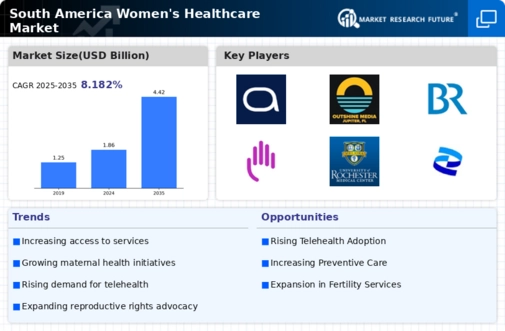Market Growth Projections
Government Initiatives and Support
Government initiatives aimed at improving women's health are significantly influencing the Global South America Women's Healthcare Market Industry. Various South American governments are implementing policies to enhance healthcare access, particularly for underserved populations. Programs focusing on maternal health, reproductive rights, and preventive care are being prioritized. These initiatives not only improve health outcomes but also encourage investment in women's healthcare infrastructure. As a result, the market is expected to grow at a CAGR of 5.1% from 2025 to 2035, reflecting the positive impact of governmental support on women's health services.
Focus on Mental Health and Wellness
The focus on mental health and wellness is emerging as a significant driver in the Global South America Women's Healthcare Market Industry. Mental health issues, particularly among women, are gaining recognition, leading to increased demand for mental health services. This shift is prompting healthcare providers to integrate mental health support into their offerings, addressing conditions such as anxiety and depression. As awareness continues to grow, it is likely that more resources will be allocated to mental health services for women. This trend aligns with the overall market growth, as it reflects a comprehensive approach to women's healthcare.
Technological Advancements in Healthcare
Technological advancements are playing a crucial role in shaping the Global South America Women's Healthcare Market Industry. Innovations such as telemedicine, mobile health applications, and wearable health devices are enhancing access to healthcare services for women. These technologies facilitate remote consultations and health monitoring, which are particularly beneficial in rural areas where healthcare access is limited. As these technologies become more integrated into healthcare systems, they are likely to drive market growth. The anticipated growth trajectory suggests that by 2035, the market could reach 78.9 USD Billion, indicating a strong shift towards tech-enabled healthcare solutions.
Rising Awareness of Women's Health Issues
There is a growing awareness of women's health issues across South America, which is positively impacting the Global South America Women's Healthcare Market Industry. Educational campaigns and advocacy efforts are informing women about various health conditions, including hormonal disorders and mental health issues. This increased awareness is leading to higher rates of diagnosis and treatment, as women seek medical advice and support. Consequently, healthcare providers are adapting their services to meet this demand, further driving market growth. The market's expansion is indicative of a broader societal shift towards prioritizing women's health.
Increasing Demand for Preventive Healthcare Services
The Global South America Women's Healthcare Market Industry is witnessing a notable increase in demand for preventive healthcare services. Women are becoming more proactive about their health, seeking regular screenings and check-ups. This trend is driven by rising awareness of health issues such as breast and cervical cancer, which are prevalent in the region. As a result, healthcare providers are expanding their offerings to include preventive services, contributing to the market's growth. In 2024, the market is projected to reach 45.67 USD Billion, reflecting the increasing prioritization of women's health and wellness.













